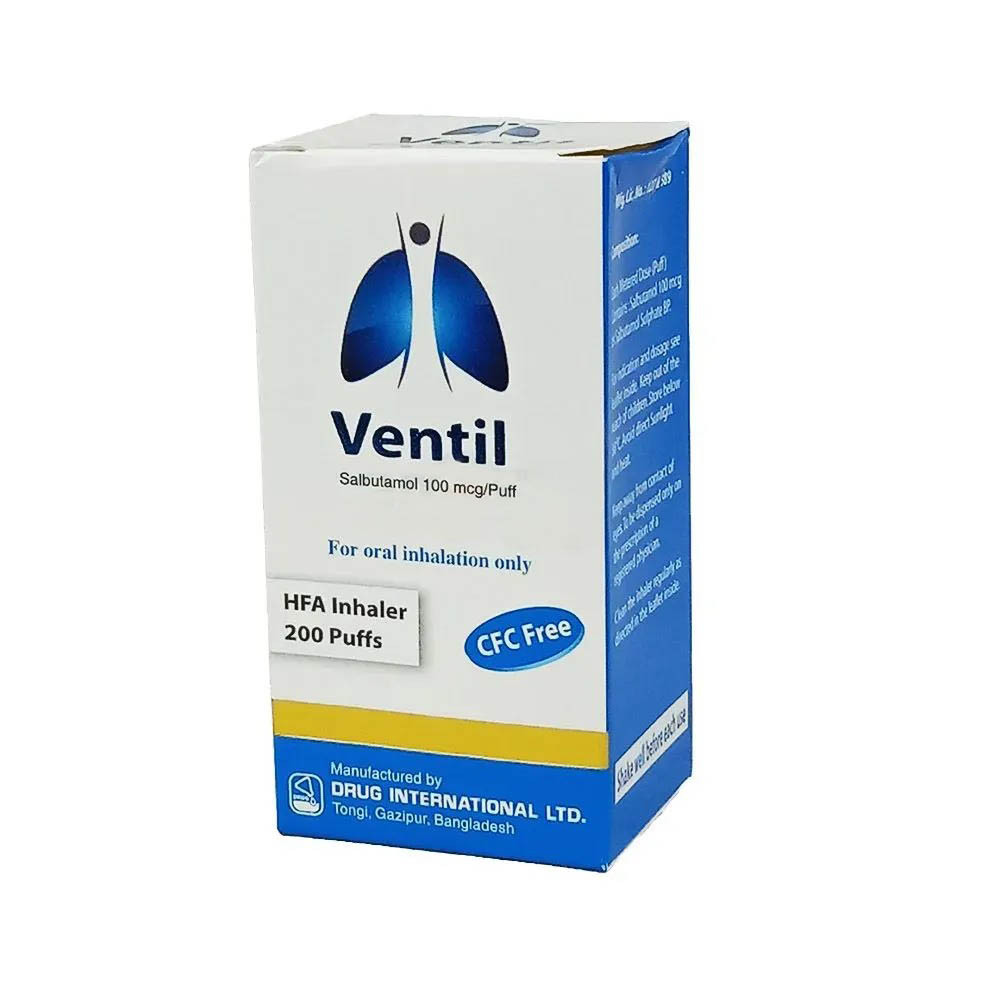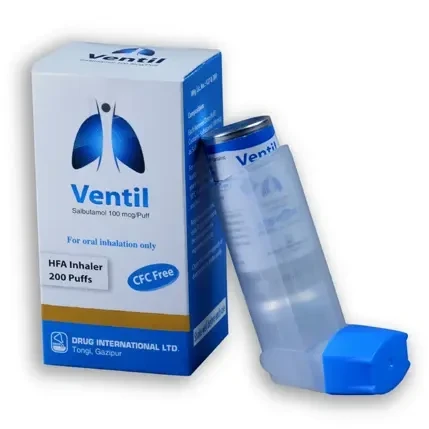200 metered doses:
৳ 190.00
Indications
Bronchospasm: Ventil Inhaler is indicated for the treatment or prevention of bronchospasm in bronchial asthma and for the treatment of reversible airway obstruction associated with bronchitis and emphysema.
Exercise-Induced Bronchospasm: Ventil Inhaler may be used to relieve attacks of acute dyspnoea and may also be taken prophylactically before exertion or to prevent exercise-induced.
Exercise-Induced Bronchospasm: Ventil Inhaler may be used to relieve attacks of acute dyspnoea and may also be taken prophylactically before exertion or to prevent exercise-induced.
* রেজিস্টার্ড চিকিৎসকের পরামর্শ মোতাবেক ঔষধ সেবন করুন
Pharmacology
Salbutamol is a selective β2-adrenoceptor agonist. At therapeutic doses, it acts on the β2-adrenoceptors of bronchial smooth muscle, with little or no action on the β1-adrenoceptors of cardiac muscle. Salbutamol provides short-acting (4-6 hours) bronchodilatation with a fast onset (within 5 minutes) in reversible airway obstruction. It also has an anti-inflammatory effect on mast cells causing inhibition of release of bronchoconstrictor mediators including histamine, neutrophil chemotactive factor (NCF) and prostaglandin D2.
Dosage
Administer Salbutamol Inhaler by oral inhalation only. Shake Salbutamol Inhaler well before each spray.
For relief of acute episodes of bronchospasm:
For relief of acute episodes of bronchospasm:
- Adults: 1 or 2 puffs as necessary. The maximum dose is up to 8 puffs in 24 hours.
- Children: Half the adult dose.
- Adults: 2 puffs 15 minutes prior to exercise or exposure to the allergen. The maximum dose is 2 puffs, up to 4 times a day.
- Children: Half the adult dose.
- Adults: Up to 200 mcg (2 puffs) four times daily.
- Children: Up to 200 mcg (2 puffs) four times daily.
* রেজিস্টার্ড চিকিৎসকের পরামর্শ মোতাবেক ঔষধ সেবন করুন
Administration
Using an Inhaler seems simple, but most patients do not know how to use it in the right way. If the Inhaler is used in the wrong way, less medicine can reach the lungs. Correct and regular use of the Inhaler will prevent or lessen the severity of asthma attacks.
Following simple steps can help to use Inhaler effectively (According to "National Asthma Guidelines for Medical Practitioners" published by Asthma Association):
Following simple steps can help to use Inhaler effectively (According to "National Asthma Guidelines for Medical Practitioners" published by Asthma Association):
- Take off the cap.
- Shake the inhaler (at least six times) vigorously before each use.
- If the inhaler is new or if it has not been used for a week or more, shake it well and release one puff into the air to make sure that it works.
- Breathe out as full as comfortably possible & hold the inhaler upright.
- Place the actuator into mouth between the teeth and close lips around the mouthpiece.
- While breathing deeply and slowly through the mouth, press down firmly add fully on the canister to release medicine.
- Remove the inhaler from mouth. Continue holding breath for at least for 10 seconds or as long as it is comfortable.
- If doctor has prescribed more than one inhalation per treatment, wait 1 minute between puffs (inhalations). Shake the inhaler well and repeat steps 4 to 7.
- After use, replace the cap on the mouthpiece. After each treatment, rinse mouth with water.
- Check your technique in front of a mirror from time to time, if you see a white mist during the inhalation, you may not have closed your lips properly around mouthpiece, or you may not be breathing in as you press the can. This indicates failure of technique. If this happens, repeat the procedure from step 4 carefully.
* রেজিস্টার্ড চিকিৎসকের পরামর্শ মোতাবেক ঔষধ সেবন করুন
Interaction
Ventil and non-selective beta-blocking drugs such as propranolol should generally not be prescribed together. Potentially serious hypokalaemia may result from β2-agonist therapy. Particular caution is advised in acute severe asthma as this effect may be potentiated by concomitant treatment with xanthine derivatives, steroids, diuretics, and by hypoxia. It is recommended that serum potassium levels are monitored in such situations.
Contraindications
Salbutamol inhaler is contraindicated in patients with a history of hypersensitivity to salbutamol or any other components of Salbutamol inhaler.
Side Effects
Ventil is generally well tolerated. Few side effects have been observed during inhalation. There are tremors, anxiety, muscle cramps, headache, palpitation, a compensatory small increase in heart rate, cardiac arrhythmias (including atrial fibrillation, supraventricular tachycardia and extrasystoles), tachycardia may occur in some patients. Mouth and throat irritation may occur with inhaled Ventil
Pregnancy & Lactation
Pregnancy Category C. There are no adequate and well-controlled studies of Salbutamol inhaler or salbutamol sulfate in pregnant women. This inhaler should be used during pregnancy only if the potential benefit justifies the potential risk to the fetus. It is not known whether the components of Salbutamol inhaler are excreted in human milk. Caution should be exercised when this inhaler is administered to a nursing woman.
Precautions & Warnings
Paradoxical Bronchospasm: Inhaled Ventil sulfate can produce paradoxical bronchospasm, which may be life-threatening. If paradoxical bronchospasm occurs, the Ventil inhaler should be discontinued immediately and alternative therapy instituted. It should be recognized that paradoxical bronchospasm when associated with inhaled formulations; frequently occurs with the first use of a new canister.
Cardiovascular Effects: Ventil inhaler, like all other β2-adrenergic agonists, can produce clinically significant cardiovascular effects in some patients such as changes in pulse rate or blood pressure. If such effects occur, Ventil inhaler may need to be discontinued. In addition, beta-agonists have been reported to produce electrocardiograms (ECG) changes, such as flattening of the T wave, prolongation of the QTc interval, and ST-segment depression. The clinical relevance of these findings is unknown. Therefore, Ventil inhaler, like all other sympathomimetic amines, should be used with caution in patients with underlying cardiovascular disorders, especially coronary insufficiency, cardiac arrhythmias, and hypertension.
Immediate Hypersensitivity Reactions: Immediate hypersensitivity reactions may occur after administration of Ventil sulfate inhalation aerosol, as demonstrated by cases of urticaria, angioedema, rash, bronchospasm, anaphylaxis, and oropharyngeal edema. Discontinue Ventil inhaler if immediate hypersensitivity reactions occur.
Coexisting Conditions: Ventil inhaler, like other sympathomimetic amines, should be used with caution in patients with convulsive disorders, hyperthyroidism, or diabetes mellitus and in patients who are unusually responsive to sympathomimetic amines. Large doses of intravenous Ventil have been reported to aggravate preexisting diabetes mellitus and ketoacidosis.
Cardiovascular Effects: Ventil inhaler, like all other β2-adrenergic agonists, can produce clinically significant cardiovascular effects in some patients such as changes in pulse rate or blood pressure. If such effects occur, Ventil inhaler may need to be discontinued. In addition, beta-agonists have been reported to produce electrocardiograms (ECG) changes, such as flattening of the T wave, prolongation of the QTc interval, and ST-segment depression. The clinical relevance of these findings is unknown. Therefore, Ventil inhaler, like all other sympathomimetic amines, should be used with caution in patients with underlying cardiovascular disorders, especially coronary insufficiency, cardiac arrhythmias, and hypertension.
Immediate Hypersensitivity Reactions: Immediate hypersensitivity reactions may occur after administration of Ventil sulfate inhalation aerosol, as demonstrated by cases of urticaria, angioedema, rash, bronchospasm, anaphylaxis, and oropharyngeal edema. Discontinue Ventil inhaler if immediate hypersensitivity reactions occur.
Coexisting Conditions: Ventil inhaler, like other sympathomimetic amines, should be used with caution in patients with convulsive disorders, hyperthyroidism, or diabetes mellitus and in patients who are unusually responsive to sympathomimetic amines. Large doses of intravenous Ventil have been reported to aggravate preexisting diabetes mellitus and ketoacidosis.
Use in Special Populations
Use in children: The safety and effectiveness of Ventil inhaler in children 4 years of age and older have been established.
Therapeutic Class
Short-acting selective & β2-adrenoceptor stimulants
Storage Conditions
Pressurized canister. Do not puncture, break or burn even when apparently empty. Keep away from sunlight and heat. Store below 30°C. Do not freeze. Keep away from eyes. Keep away from children. To be dispensed only on or by the prescription of a registered physician.
Pack Images: Ventil 100 mcg Inhaler


